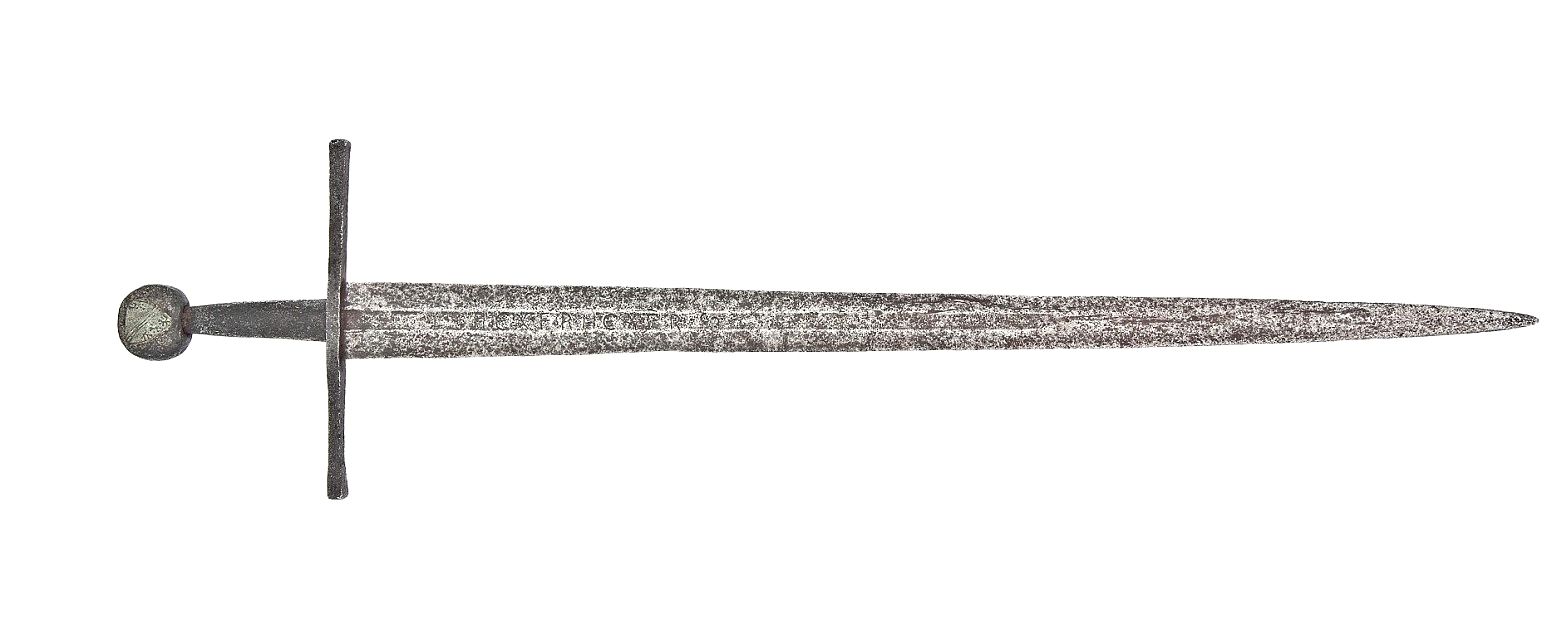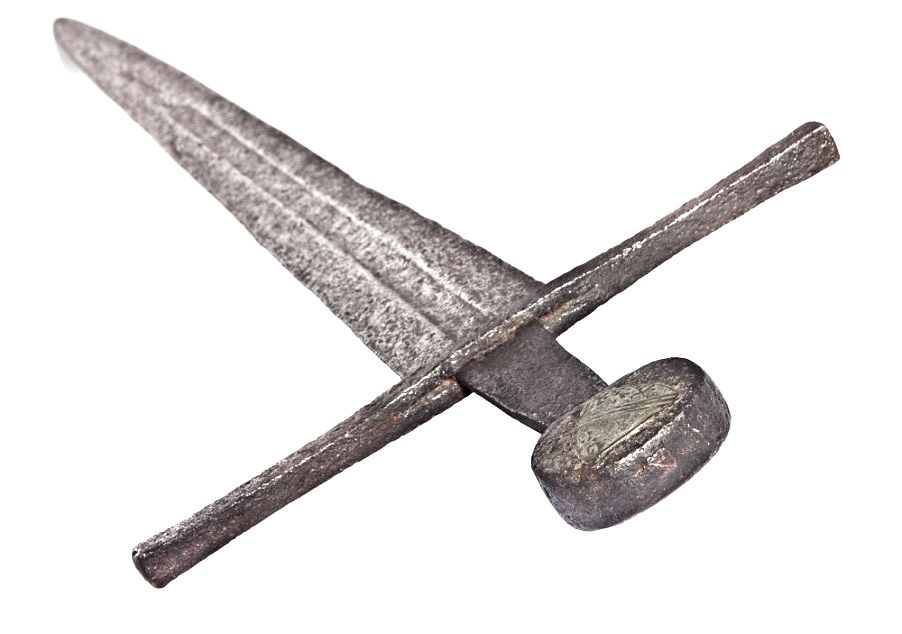Oakeshott Type XII Sword w/ Unusually Well Recorded History
Aug 5, 2014 12:42:11 GMT
Post by Jack Loomes on Aug 5, 2014 12:42:11 GMT



AN EXTREMELY RARE LATE MEDIEVAL BROADSWORD WITH EARLIER VIKING BLADE AND BEARING THE ARMS OF THE DE BOHUN FAMILY, EARLS OF HEREFORD AND ESSEX
THE BLADE MID-11th CENTURY, THE GUARD AND POMMEL 13th/14th CENTURY
With tapering double-edged fullered blade, iron cross-guard slightly swelled at each tip, short tang, and flattened iron wheel pommel inlaid with a copper shield on each side bearing the de Bohun coat of arms, each shield retaining traces of original gilding and enamelled inlay
27 7/8 in. (70.7cm.) blade
A runic inscription is clearly visible within one fuller
The blade has been slightly shortened and reprofiled to a tapering point, the original Viking profile ending with a rounded point. The fuller on each side has been partially filled towards the tip by molten iron to shorten the groove in proportion to the tapering tip.
The 1319 Will of Sir Humphrey De Bohun, 4th Earl of Hereford and Essex (1276-1322), held in the Public Records Office, makes specific mention of four swords in the inventory of personal property of the Earl:
"iiij. Espeies. Lun des armes le dit Counte, lantre de Saint George et le tierce Sarziney, le quarte de Guerre”
A translation from old French is “Four swords, one with arms of said earl, the second of Saint George, and the third of ‘Sarziney’, the fourth of war”. It is the first mentioned of these four swords that is of present interest.
The narrative surrounding this sword begins in 1066 and a kinsman (or possibly god father) of William The Conqueror, one Humphrey De Bohun (a literal translation being Humphrey 'with the beard'). Humphrey, depicted on the Bayeux Tapestry seated at the banquet table of Bishop Odo, accompanied William on his campaign gaining the lordship of Taterford in Norfolk for his troubles. It is known that Humphrey De Bohun fought at the battle of Senlac, better known as Hastings in October 1066 where the army of King Harold Godwinson was defeated by the Normans. Less than three weeks earlier, Harold had defeated the Viking army of the Norwegian King Hardrada and his own brother Tostig Godwinson at Stamford Bridge in Yorkshire.
Whilst it cannot be proved, it is not at all inconceivable that the blade of the present sword was captured or taken as a trophy by de Bohun at Hastings and was later remounted to become a family sword. The English army who faced William in Sussex would conceivably be armed with some Viking weapons, especially having routed the Norwegians in Yorkshire there would have been plenty available to be pressed into service against this new threat. A Viking sword with an identical runic inscription was discovered by Dr. Jorma Leppäaho near Jamsa in central Finland during an excavation of a mid-11th century Viking burial, with the find first being published in the mid-1960s in a Finnish archaeological publication. The sword, originally found curled, is housed in the Suomen Kansallismuse in Helsinki, and has only come to the attention of a wider audience since publication in Swords of the Viking Age in 2002. A second excavated Viking sword with identical runic inscription, believed to have been found in the banks of the river Derwent (in the very close vicinity to the site of the battle at Stamford Bridge), is held in a private British collection. With both these other swords retaining precious metal inlay to a greater or lesser degree to their runic inscriptions, it is entirely possible that the present blade was equally as lavishly decorated.
Moving forward several generations to Sir Humphrey de Bohun, 4th Earl of Hereford and Essex, we find the family at the very centre of English society and Sir Humphrey Constable of England. A seasoned campaigner in Scotland having served both Edward I and Edward II, he and his wife Elizabeth (daughter of Edward I) were entrusted as custodians of Elizabeth de Burgh, queen to King Robert I of Scotland (Robert Bruce) who was captured by the English following Robert’s 1306 rebellion, taking of the Scottish crown and subsequent self-imposed exile. By June 1314 and out of favour with the King, not for the first time, Sir Humphrey together with the Earl of Gloucester, Sir Gilbert De Claire, shared command of the English army raised to fight King Robert of Scotland.
The battle of Bannockburn, celebrating its 700th anniversary this year, was a resounding victory for Scotland. Sir Humphrey was in the thick of the battle, witnessed his young nephew Henry de Bohun fall victim to King Robert’s axe, and joined the retreat after it became clear on the second day of fighting that victory belonged to the Scots. He was taken prisoner at Bothwell Castle and eventually ransomed for the safe return of King Robert’s queen, Elizabeth, his daughter Marjorie Bruce, two bishops and other prominent Scots captives. The present sword, whilst not being a war sword, would have served as a clear badge of identity with its gold and enamelled coat of arms on the pommel and eminently more practical as a side arm around camp when not mounted and armed for battle. It is therefore entirely possible that this sword was present at Bannockburn in June 1314 if not actually on the field of battle.
The 4th Earl of Hereford and Essex met with a particularly gruesome end at the battle of Boroughbridge in March 1322, a demise that has found favour with a younger modern audience through the Horrible Histories series of books. Having joined the Earl of Lancaster in revolt against Edward II, Sir Humphrey was leading a charge across the bridge on foot when a pikeman concealed beneath the bridge thrust his weapon through the planks allegedly skewering Sir Humphrey through the anus, his agonising and vocal death turning the attack into a retreat.
The sword and the heraldic device have been together for around the last fifty years, first in the Corrigan Collection and subsequently with the vendor. The whereabouts of the sword prior to Corrigan’s ownership is not known, but the mention of a family sword bearing the de Bohun arms in Sir Humphrey’s Will of 1319 and the use of a mid-11th century Viking blade makes for an interesting train of thought potentially linking significant events of British history from the Vikings, Hastings and Bannockburn through this object. A series of x-rays which accompany the sword and heraldic device support the age of the items and show no modern repairs.
For further reading please see:
Ian Peirce, Swords of the Viking Age, 2009 ed., p. 136
The Archaeological Journal, Vol. II, London, 1846,T.H. Turner, The Will of Humphrey de Bohun, Earl of Hereford and Essex, with Extracts from the Inventory of his Effects, A.D. 1319-1322, pp. 339-349
The American Historical Review, April 1896, Melville M. Bigelow, The Bohun Wills, pp. 414-435
For more information on Oakeshott Type XII swords see this extract of Ewart Oakeshott's Records of the Medieval Sword: sword-site.com/thread/676/oakeshott-type-xii-defined-ewart
See also this article in the Daily Mail (UK): Is this England's Most Unlucky Sword?
Source: www.christies.com

.png?width=1920&height=1080&fit=bounds)